I was about to plot a Poincare section of the following DE, which is quite meaningful to have a periodic potential function V(x) = - cos(x) in this equation.
After calculating the solution using RK4 with time interval dt = 0.001, the one that python drew was as the following plot.
But according to the textbook(referred to 2E by J.M.T. Thompson and H.B. Stewart), the section would look like as
it has so much difference. For my personal opinion, since Poincare section does not appear as what writers draw, there must be some error in my code. However, I actually done for other forced oscillation DE, including Duffing's equation, and obtained the identical one as those in the textbook. So, I was wodering if there are some typos in the equation given by the textbook, or somewhere else. I posted my code, but might be quite messy to understand. So appreicate dealing with it.
import numpy as np
import matplotlib.pylab as plt
import matplotlib as mpl
import sys
import time
state = [1]
def print_percent_done(index, total, state, title='Please wait'):
percent_done2 = (index+1)/total*100
percent_done = round(percent_done2, 1)
print(f'\t⏳{title}: {percent_done}% done', end='\r')
if percent_done2 > 99.9 and state[0]:
print('\t✅'); state = [0]
####
no = 1
####
def multiple(n, q):
m = n; i = 0
while m >= 0:
m -= q
i += 1
return min(abs(n - (i - 1)*q), abs(i*q - n))
# system(2)
#Basic info.
filename = 'sinPotentialWell'
# a = 1
# alpha = 0.01
# w = 4
w0 = .5
n = 1000000
h = .01
t_0 = 0
x_0 = 0.1
y_0 = 0
A = [(t_0, x_0, y_0)]
def f(t, x, y):
return y
def g(t, x, y):
return -0.5*y - np.sin(x) + 1.1*np.sin(0.5*t)
for i in range(n):
t0 = A[i][0]; x0 = A[i][1]; y0 = A[i][2]
k1 = f(t0, x0, y0)
u1 = g(t0, x0, y0)
k2 = f(t0 + h/2, x0 + h*k1/2, y0 + h*u1/2)
u2 = g(t0 + h/2, x0 + h*k1/2, y0 + h*u1/2)
k3 = f(t0 + h/2, x0 + h*k2/2, y0 + h*u2/2)
u3 = g(t0 + h/2, x0 + h*k2/2, y0 + h*u2/2)
k4 = f(t0 + h, x0 + h*k3, y0 + h*u3)
u4 = g(t0 + h, x0 + h*k3, y0 + h*u3)
t = t0 + h
x = x0 + (k1 + 2*k2 + 2*k3 + k4)*h/6
y = y0 + (u1 + 2*u2 + 2*u3 + u4)*h/6
A.append([t, x, y])
if i%1000 == 0: print_percent_done(i, n, state, 'Solving given DE')
#phase diagram
print('showing 3d_(x, y, phi) graph')
PHI=[[]]; X=[[]]; Y=[[]]
PHI_period1 = []; X_period1 = []; Y_period1 = []
for i in range(n):
if w0*A[i][0]%(2*np.pi) < 1 and w0*A[i-1][0]%(2*np.pi) > 6:
PHI.append([]); X.append([]); Y.append([])
PHI_period1.append((w0*A[i][0])%(2*np.pi)); X_period1.append(A[i][1]); Y_period1.append(A[i][2])
phi_period1 = np.array(PHI_period1); x_period1 = np.array(X_period1); y_period1 = np.array(Y_period1)
print('showing Poincare Section at phi=0')
plt.plot(x_period1, y_period1, 'gs', markersize = 2)
plt.plot()
plt.title('phi=0 Poincare Section')
plt.xlabel('x'); plt.ylabel('y')
plt.show()



